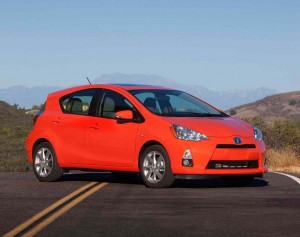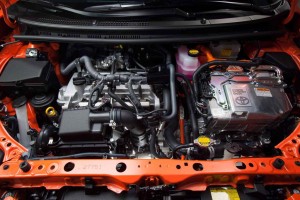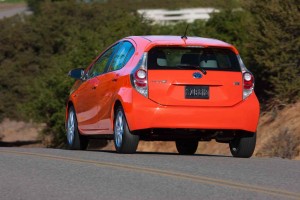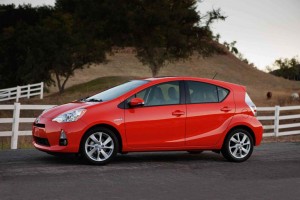A recent survey found that the overwhelming majority of Millennial motorists would like to buy a hybrid. The numbers aren’t all that much lower for Gen-X and Baby Boomers, either. Yet desire doesn’t translate into action when it comes to the marketplace, it seems, where hybrids continue to commend barely 2% of the overall U.S. market.
The good news for Toyota is that its familiar Prius remains the nation’s best-selling hybrid, accounting for roughly half of all gas-electric vehicle sales in 2011. So, it’s probably no surprise the maker would want to take advantage of the Prius name, Toyota in the midst of rolling out an entire family of hybrids sharing that popular badge.
The first of those new entries, the bigger Prius V, hit market last year. Now comes the Prius C. Compact? Yep. Cheap? True again, at least if you opt for the basic Prius C One. So, will buyers connect with the smallest member of the growing family? That’s what we hoped to find out during our first chance to drive the 2012 Prius C around the environmentally friendly San Diego suburbs.
The original Prius is nearly ubiquitous in Southern California, whether buyers there are truly hoping to save money while nurturing the planet or simply looking to show off their green bona fides. While many of the more affluent members of the community can readily afford the premium for the original Prius, the maker is hoping to draw in plenty of additional customers – like the students at the University of California San Diego – with a price tag that starts at barely $19,000.
But there’s a big asterisk attached to that lowball entry point, one that leads us to offer a warning that the sticker you may actually see — once you add on some basic necessities and niceties like seat heaters – could run significantly higher than what Toyota will be promoting.
The Prius C, despite Toyota’s claims to the contrary, is effectively a subcompact Yaris with a battery pack. And a much smaller one than what you’ll find in the larger Prius hatchback and V models. It weighs just 67 pounds and packs in a modest 0.87 kilowatt-hours of energy. The entire Hybrid Synergy Drive system readily packages out of sight, and with those batteries tucked under the back seat there is surprisingly little compromise to cargo and passenger space. The compromises come in the drive experience.
With an equally pint-sized 1.5-liter gasoline engine – which uses the efficient if anemic Atkinson Cycle – mated to the Hybrid Synergy Drive’s electric motor, the Prius C makes a modest 99 horsepower. That’s routed through the front wheels through a gearbox that effectively operates like a CVT.
So, expect to have the usual issues associated with a continuously variable transmission, notably that rubber band feeling as the engine revs up while the vehicle struggles to catch up. And it will take a while to do so. With a 0 to 60 time officially rated at around 11.5 seconds despite its relatively modest weight, the Prius C isn’t exactly a sports car, despite Toyota’s plan to pitch it as a sporty, affordable alternative.
As with the other Prius-badged models, the Prius C is capable of operating on battery power alone, we were told during an extensive background presentation, although the limited battery size means you won’t be able to get very far. Or very fast. Ostensibly, the top speed in EV mode is 26 mph. Even with the battery fully charged we never came close. And tipping in the throttle even slightly led to the gasoline engine immediately firing up and taking over.
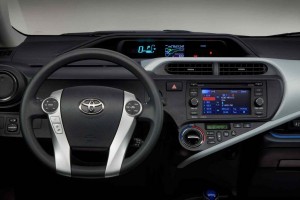
The Prius C features built-in apps that give a driver a game-look way of improving their mileage.The original Prius C concept.
We didn’t get much opportunity to test out the handling of the new Prius C, never extending our drive as far as the challenging mountain passes to the east of San Diego. But even the less challenging hill country nearer by made for a clear comparison to similarly sized products. Like most entries in its segment, the Prius C features a MacPherson strut front suspension and torsion bar rear. But it simply doesn’t nudge into the fun-to-drive category like the new Chevrolet Sonic or the Nissan Versa.
Not unless your idea of fun is watching the creative applications Toyota has embedded into the vehicle showing you when you’re driving at peak efficiency and revealing just how much fuel and CO2 gases you’ve saved. If fuel economy is your metric, here the Toyota Prius C scores big, at 53 mpg on the highway and 50 combined – which is the closest number to what you can expect in the real world.
That’s about 3 mpg more than the original Prius, which is actually a little bit less of a bump-up than we might expect, but for the money, it would seem a good deal.
Of course, size isn’t the only thing you’ll give up for that $19,000 price tag for the Toyota Prius C One. This is not the classic “stripper.” There’s a radio, air conditioning and power windows, among other features. But what surprised us was what was not only offered as stock equipment but not even available as an option. You have to go all the way up to the Prius C Four, the $23,990 top-line model, to get fog lights and seat heaters.
You can get the high-tech EnForm infotainment system and navigation in a lower-level model at $22,395.
We expect the lack of seat heaters, even in option form, will prove a serious disconnect with buyers in climates colder than San Diego. And it appears Toyota planners are rethinking that off decision, but an update likely wouldn’t be made until sometime in 2013, we were told.
Too bad. While the 2012 Toyota Prius C is not our favorite driver’s car, it features a reasonably well-outfitted interior and simply amazing fuel economy. It is likely to extend the appeal of the Prius nameplate, just as Toyota planned, as long as buyers don’t mind some genuinely strange omissions, like those seat heaters.

